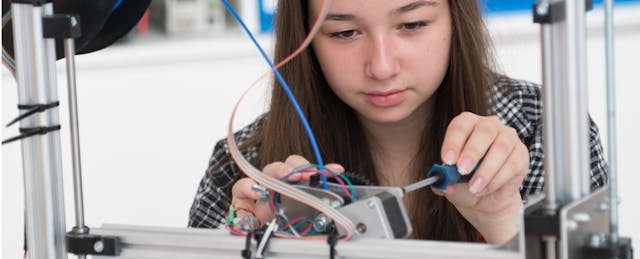Jackie, the team captain of St. Mary’s all-girls robotics team, knows a thing or two about breaking the mold. During a panel on the importance of STEM education for women, she explained what it’s like to be a female student competing in a male-dominated program: “Not only were we the only all-girls robotics team,” she explained of a recent competition, “we were the only team that actually allowed girls to touch the robots.”
Jackie’s experience demonstrates how essential it remains to support STEM education designed for women, particularly in engineering and computer science, which remain disproportionately dominated by men. It’s a mission we live by at St. Mary’s Academy (SMA), an all-girls high school located in the heart of Portland, Ore., which has been dedicated to promoting female education for the last 157 years. At SMA, we know that young women thrive when given the chance to choose how and what they learn, while at the same time being supported by a community that believes they can succeed, regardless of gender.
That’s why we’ve committed to blended, student-centered learning, with a goal of not only improving student outcomes, but getting more female students passionate about STEM. It’s been inspiring, sometimes scary, and it’s still a work-in-progress. Regardless, we’ve met great success, with more than 40 percent of SMA graduates intending to pursue college majors in math or science. Now, it’s nearly impossible for most of us to remember what it was like to work solely with paper and overhead projectors. And none of us would go back.

Using blended learning to personalize instruction
Five years ago, SMA launched a 1:1 iPad initiative designed to put technology in the hands of every student so she could have greater control over her own learning. All of us—students and teachers—have worked hard since then to find creative, effective ways to take advantage of the initiative. We’ve found that the key to successfully integrating technology is to focus first on good instructional strategies, particularly those that are student-centered and collaborative, then incorporate technology where it adds value.
Many teachers now run paperless (or nearly paperless) classrooms, giving them back hours of extra instructional time. Many flip lessons, using videos, websites, and digital presentations rather than traditional lectures. They hold online discussions, offer design challenges and genius hours, and share feedback digitally. Students spontaneously research questions in class, collaborate with each other online, and show what they know through Kahoot! or GoFormative quizzes. They complete research projects that culminate in video or audio assessments, and submit multimedia reflections through Notability and Flipgrid.
My favorite example of the power of blended learning happened this winter, when snow forced Portland schools to close 10 days over two months, threatening to undermine learning. Yet because of the tech we’d invested in, teachers and students were able to persist. We turned to Padlet for collaborative, online work, FaceTime and Google Hangouts for discussions, and Schoology for sharing video and audio assessments. It was creative and dynamic—a true demonstration that learning need no longer be confined to the four walls of a classroom.

Getting girls into tech, with tech
But a 1:1 program was just the first step in preparing students for potential careers in STEM. Research shows that women are more likely to pursue employment in tech fields if they have positive experiences with computer science and STEM mentorship throughout their K-12 education. So to give our young women the best chance at success, we needed to create opportunities for them to truly understand and create technology, rather than just consume it.
We built up our computer science curriculum to include a required, semester-long Technology Foundations class for all freshmen, as well as eight elective courses in computer science and creative applications. Through these courses, students have the chance to code web programs and iOS applications, program circuits and robots, learn graphic design, and promote ideas through social media and online portfolios—all essential skills in today’s technology-driven workplace.

We also recognize that not every student can fit extra classes into her busy schedule. So for the past two years, to ensure everyone has the chance to explore technology, we've offered a full week of activities during National Computer Science Week. We invite panels of women from local technology companies to share advice with students. Students are treated to expert demonstrations of technologies like AR/VR and 3D design. Our award-winning Science Olympiad program gives our young women a chance to apply their understanding of science, engineering, and technology in hands-on competitions against other teams—many of which are all-male or mostly-male.
And our all-female robotics team, the only team with girls who design, build, and troubleshoot their robot? It’s only in its second year and already winning awards.
Lifelong benefits
The rapid increase in technology tools and courses at SMA has been the result of strong support from school leadership, families, and alumnae. As one of our long-term teachers remarked, “This is feminism, people. Women need to know how to code. It’s that simple.” That support allowed us to create an official instructional technology coach position, hire additional instructors with strong technology backgrounds, and develop connections with experts in local technology companies and higher ed organizations. It hasn't been easy, but the efforts are worth it.
Every young woman at SMA now has a personal relationship with technology and science in an atmosphere that encourages her to be brave, analytical, ethical, and creative. She uses her iPad daily to personalize how she learns, creates and demonstrates her knowledge. She is exposed to the basics of technology and computer science as a freshman, and then has multiple opportunities to explore these ideas at a deeper level as she prepares for college. And all along, she is surrounded by people who believe that she can make a difference.
All you have to do is look in any industry to find SMA alumnae who continue to believe that. And that is the power of personalized education for young women.


